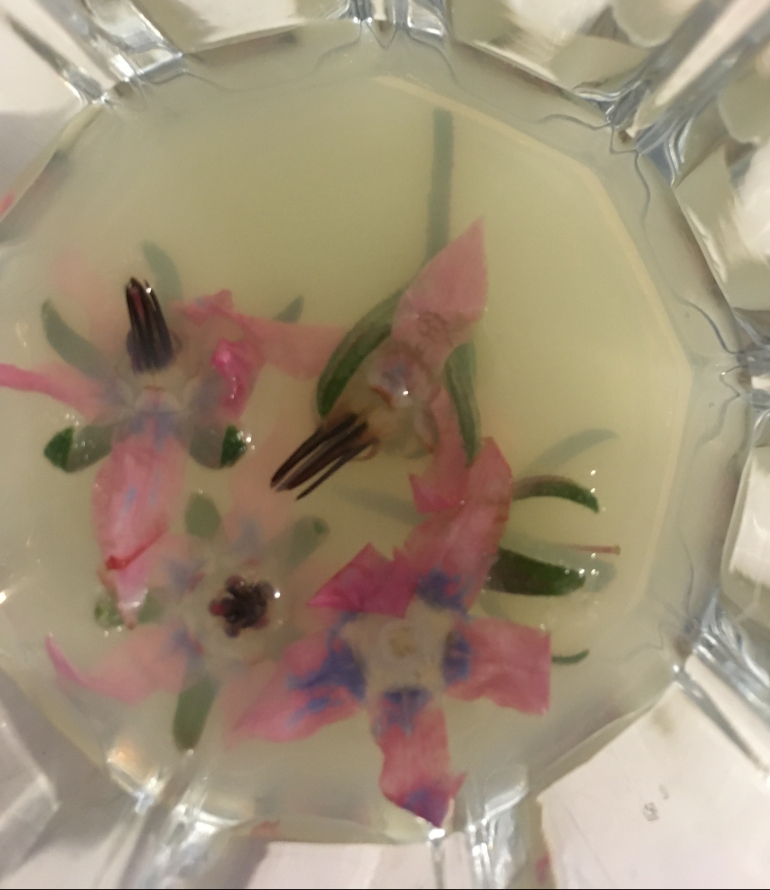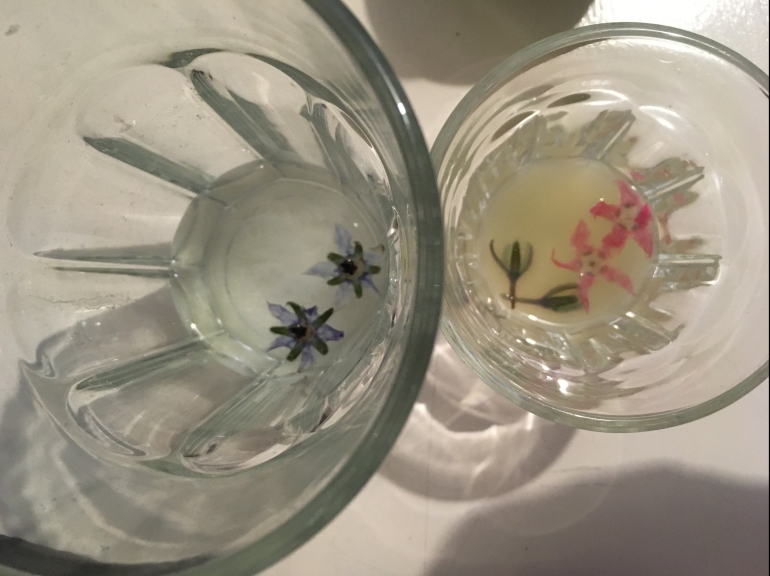Short version:
A self-seeding, upright annual that can grow to about 80cm tall. It has lovely edible blue flowers that bees and butterflies love. The young leaves can be used as a cooked green. Older leaves can be blitzed into soup.
My child thinks that I am really cruel for not growing her proper showy flowers in the garden. The general rule is – if I can’t eat it (or some part of it) I won’t grow it. Having a small garden in the city means that space is a premium. Even if I get a pot to put something fun in, that would still be a pot that I could grow something edible in. I won’t grow a bee or butterfly friendly flower for the sake of it. Some part of the plant also needs to be edible. I am, however, trying to convert the lawn into more of a bee friendly flower patch though, with edible clover and wild pansies. There’s more info how the lawn came to be here.
Borage ticks all the boxes for the little critters, the little critter and me. My little one absolutely loves grazing on the flowers and she loves to put them into drinks. We also like to make little ice cubes with them in.
How to grow
If you want very early plants, you can start them in individual in small pots from February. I say individual as the seedlings are rather large and they do grow quickly. Otherwise, the easiest way is to sow them straight into the ground around 1cm deep where you want them to grow between March and May. Give them plenty of space between plants as they can spread around 45cm. I like to squeeze them in, so I usually have them around 20cm apart. They like full sun best but will do fine in some shade. From seeing where my self-seeded seedlings have popped up, I can tell that they are not too fussy, but love a good compost.

For size comparison, at the top is a toilet roll inner tube. 
This is a week later. The true leaves have grown to about 10cm. 
One transplanted into the grass has grown less over the week.
That is something to be aware of. Once you have sown borage, you never need sow again. Self-seeded seedlings can appear as early as March, but they don’t mind being transplanted.
How to harvest

Little one was very proud of her harvest.
You can eat the young leaves. In fact, if they have self-seeded themselves into a nuisance you could pick lots of seedlings to eat. I love how borage can turn weeding into harvesting. I say ‘young’ leaves as borage leaves are a little prickly. The older the leaf the pricklier. After cooking the young leaves, the prickles will have wilted and not be noticeable. If you really want to use the older leaves it would be better to blitz them into soup. You would need some gloves to protect your hands. They don’t sting like nettles do, but they can be uncomfortable to handle. Once the flowers start appearing you can pick the flower off and eat straight away.

No matter how much you try to eat every flower (believe me, the kid has tried) you will never get them all. That’s a great thing. It’s good to leave some for the bees and butterflies. You can still eat the flowers after they have visited, but it’s hard to time harvesting after a pollinator has had a feed. The plant will give out plenty of flowers over a long period. This plant has been flowering for 6 weeks and it doesn’t show any sign of giving up. Unfortunately I didn’t stake it up so it has collapsed all over the place and it has also become a bit diseased.
How they taste
The leaves and the flowers have a cucumbery-lettucey taste.
The flowers have a bit of added sweetness due to the nectar. They are best eaten raw as a foraging snack, scattered in salads or sprinkled on dishes as a garnish.

A flower salad. Everything was from the garden. 
Close up of the lovely colours 
Went for a block of blue rather than sprinkling here.
The salad above was mostly picked by little madam. It had to be washed about 4 times due to the large amount of bugs. All ingredients were from the garden:
Borage (obviously), nasturtiums (the yellow and orange flowers should be added in moderation as they are spicy), siberian purslane (tiny pink flowers – their rather bitter taste is masked by everything else), winter purslane flowers (really tasty but not bitter – the flowers are so tiny that you pick the whole stem, with a circular leaf), there were some kale flowers (taste a bit cabbagey), there was some three cornered leek flowers (I added those, but she then demanded I remove them for being too garlicky), rose petals, Caucasian spinach leaves, dill and mint.
Borage looks and tastes great in Pimm’s. This is also where the borage ice cubes go down a treat. My four-year-old likes to put mint and borage together. It’s like she’s preparing herself to drink Pimm’s one day.

It’s a shame the tap water has so much air and impurities in it and the ice is very cloudy. 
Little one made mint and borage flavoured water.
The leaves, when cooked, are very soft. They shrink down a lot, like spinach does.
Problems

The only disease that has affected my borage, so far, is powdery mildew. This is something I get a lot in my garden – on the brassicas, tromboncinos and even on peas. Probably because I’m constantly trying to pack the plants into a small space. It is also because I get the little one involved in watering which inevitably leads to a spraying on the leaves. This provides perfect conditions for powdery mildew – humid air that doesn’t have space to circulate well. I’m afraid the best way to get rid of it is to catch it early and remove all affected leaves. If left too late the whole plant must be binned. It can’t even be recycled in the compost as the spores will make infection more likely next season.
Fun science stuff
The flowers make for a great acid test. If you put the flowers into an acidic drink, they will turn pink. It does takes quite a while though (20 mins) and happens very gradually.

After being added to lemon juice 
It gets pinker… 
…and pinker 
2 flowers are then added to a bicarbonate soda solution 
The pink fades 
It gets a slightly bluer tinge 
The alkali doesn’t fully restore the gorgeous blue of the borage though.

One thought on “Borage”